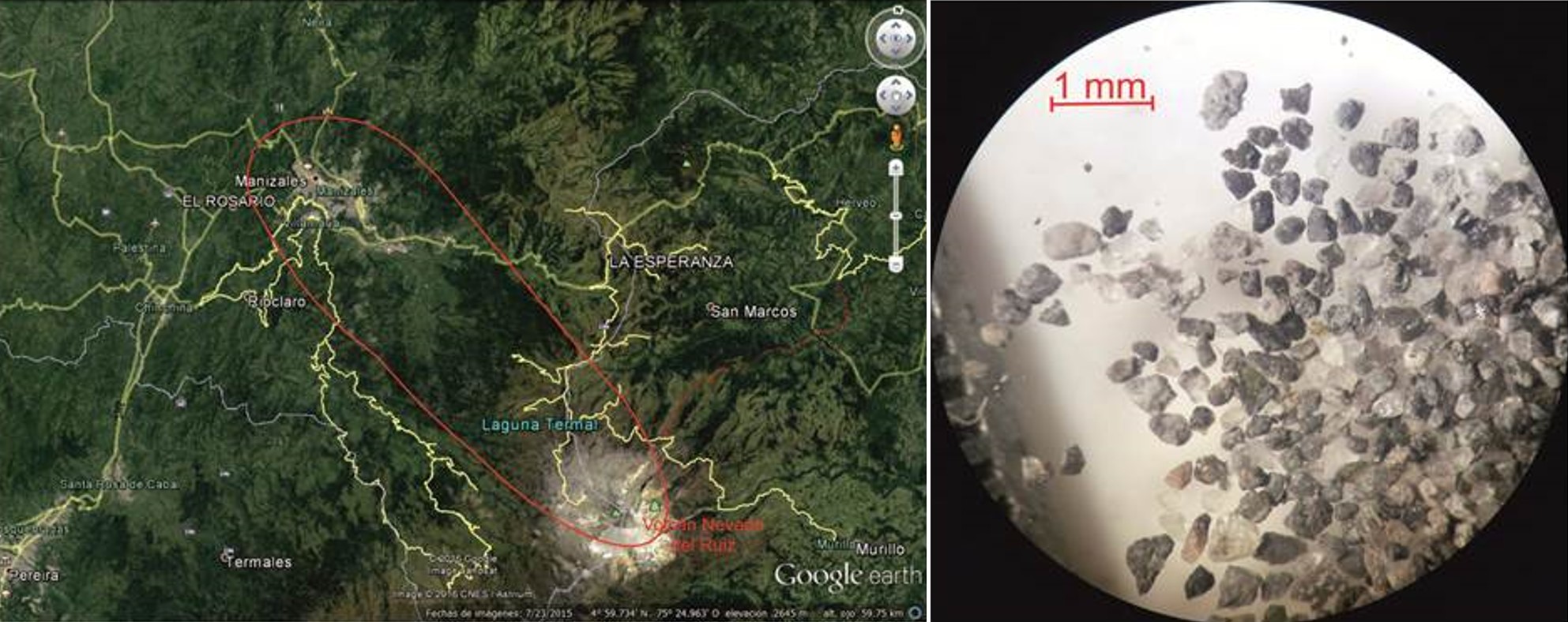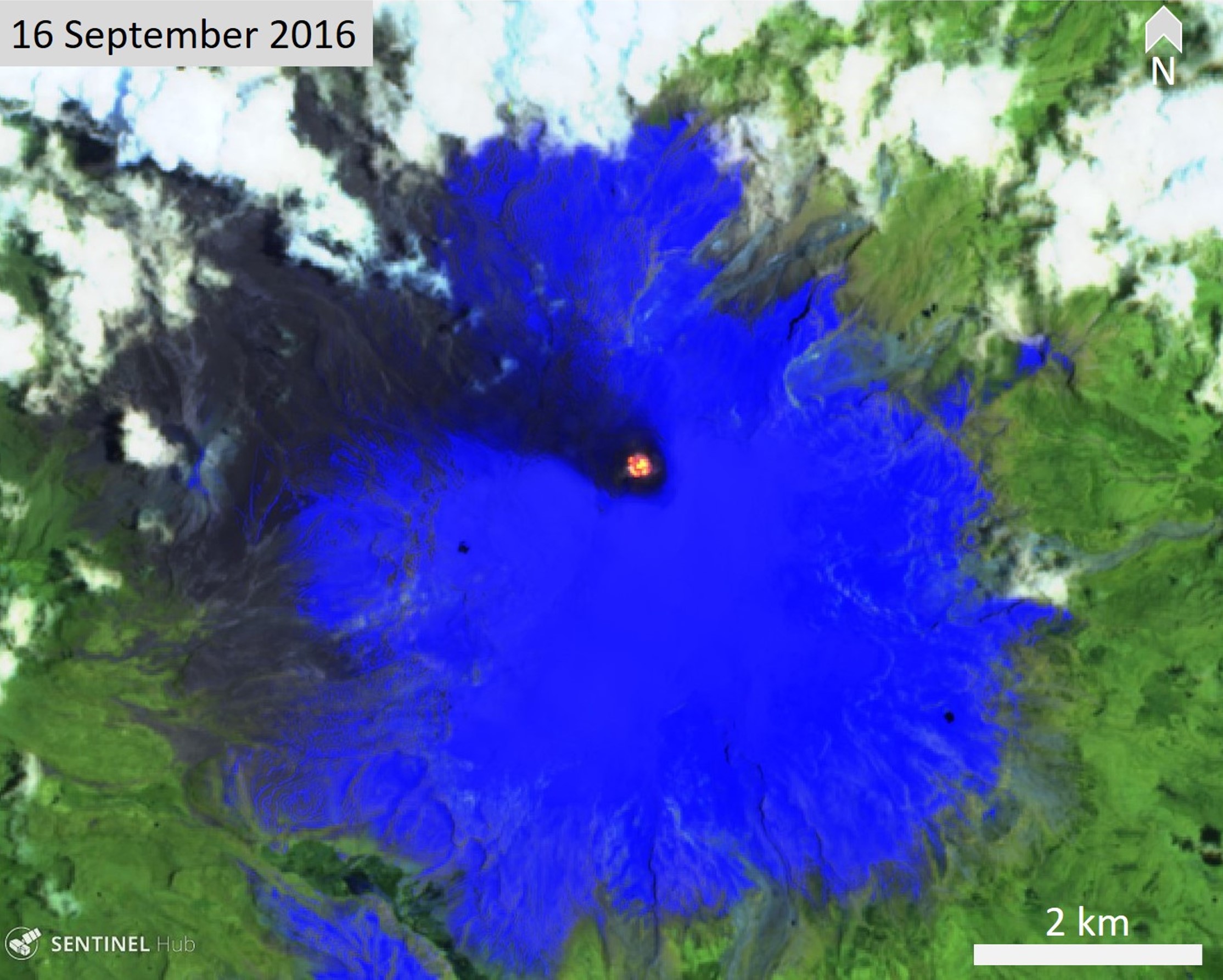Report on Nevado del Ruiz (Colombia) — December 2019
Bulletin of the Global Volcanism Network, vol. 44, no. 12 (December 2019)
Managing Editor: Edward Venzke.
Edited by Janine B. Krippner.
Nevado del Ruiz (Colombia) Intermittent ash plumes with significant gas and steam emissions during January 2016-December 2017
Please cite this report as:
Global Volcanism Program, 2019. Report on Nevado del Ruiz (Colombia) (Krippner, J.B., and Venzke, E., eds.). Bulletin of the Global Volcanism Network, 44:12. Smithsonian Institution. https://doi.org/10.5479/si.GVP.BGVN201912-351020
Nevado del Ruiz
Colombia
4.892°N, 75.324°W; summit elev. 5279 m
All times are local (unless otherwise noted)
Nevado del Ruiz is a glaciated volcano in Colombia (figure 86). It is known for the 13 November 1985 eruption that produced an ash plume and associated pyroclastic flows onto the glacier, triggering a lahar that approximately 25,000 people in the towns of Armero (46 km west) and Chinchiná (34 km east). Since 1985 activity has intermittently occurred at the Arenas crater. The eruption that began on 18 November 2014 included ash plumes dominantly dispersed to the NW of Arenas crater (BGVN 42:06). This bulletin summarizes activity during January 2016 through December 2017 and is based on reports by Servicio Geologico Colombiano and Observatorio Vulcanológico y Sismológico de Manizales, Washington Volcanic Ash Advisory Center (VAAC) notices, and satellite data.
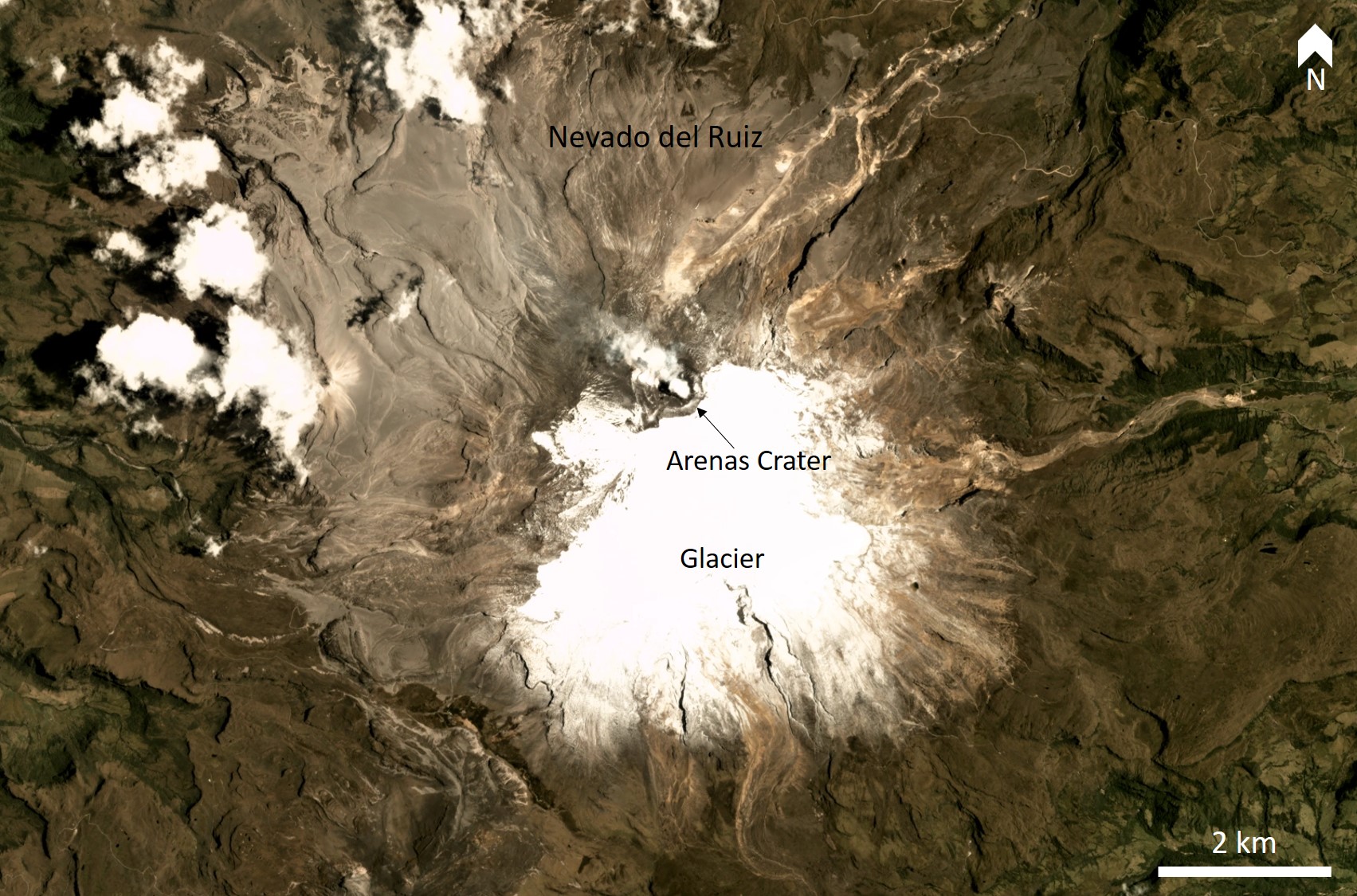 |
Figure 86. A satellite image of Nevado del Ruiz showing the location of the active Arenas crater. September 2019 Monthly Mosaic image copyright Planet Labs 2019. |
Activity during 2016. Throughout January 2016 ash and steam plumes were observed reaching up to a few kilometers. Significant water vapor and volcanic gases, especially SO2, were detected throughout the month. Thermal anomalies were detected in the crater on the 27th and 31st. Significant water vapor and volcanic gas plumes, in particular SO2, were frequently detected by the SCAN DOAS (Differential Optical Absorption Spectroscopy) station and satellite data (figure 87). A M3.2 earthquake was felt in the area on 18 January. Similar activity continued through February with notable ash plumes up to 1 km, and a M3.6 earthquake was felt on the 6th. Ash and gas-and-steam plumes were reported throughout March with a maximum of 3.5 km on the 31st (figure 88). Significant water vapor and gas plumes continued from the Arenas crater throughout the month, and a thermal anomaly was noted on the 28th. An increase in seismicity was reported on the 29th.
 |
Figure 87. Examples of SO2 plumes from Nevado del Ruiz detected by the Aura/OMI instrument on 10, 26, and 31 January 2019. Courtesy of Goddard Space Flight Center. |
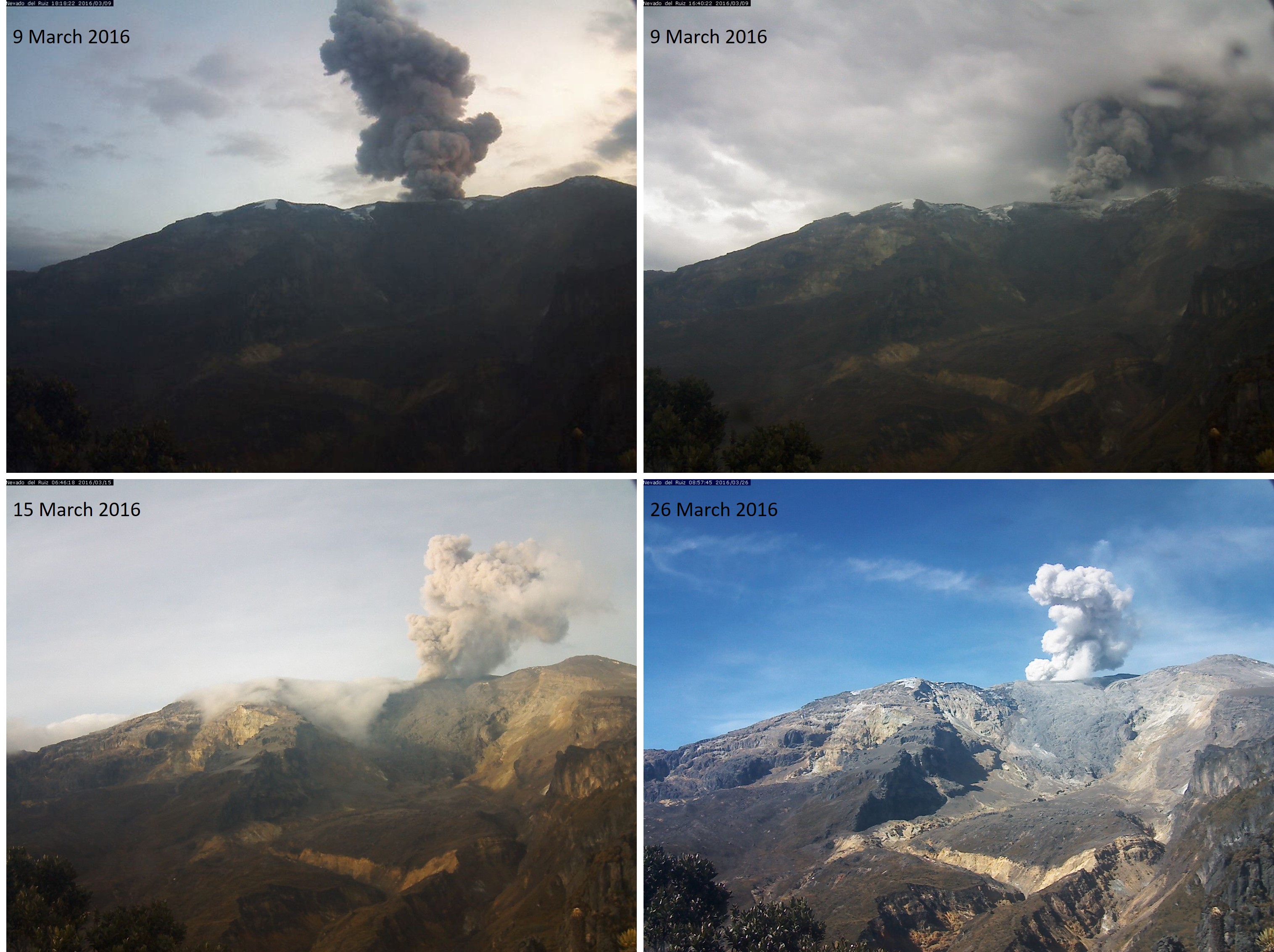 |
Figure 88. Ash plumes at Nevado del Ruiz during March. Webcam images courtesy of Servicio Geologico Colombiano, various 2016 reports. |
The activity continued into April with a M 3.0 earthquake felt by nearby inhabitants on the 8th, an increase in seismicity reported in the week of 12-18, and another significant increase on the 28th with earthquakes felt around Manizales. Thermal anomalies were noted during 12-18 April with the largest on the 16th. Ash plumes continued through the month as well as significant steam-and-gas plumes. Ashfall was reported in Murillo on the 29th.
The elevated activity continued through May with significant steam plumes up to 1.7 km above the crater during the week of 10-16. Thermal anomalies were reported on the 11th and 12th. Steam, gas, and ash plumes reached 2.5 km above the crater and dispersed to the W and NW. Ashfall was reported in La Florida on the 20th (figure 89) and multiple ash plumes on the 22nd reached 2.5 km and resulted in the closure of the La Nubia airport in Manizales. Ash and gas-and-steam emission continued during June (figure 90).
 |
Figure 90. Examples of gas-and-steam and ash plumes at Nevado del Ruiz during June and July 2016. Courtesy of Servicio Geologico Colombiano (7 July 2016 report). |
Similar activity was reported in July with gas-and-steam and ash plumes often dispersing to the NW and W. Ashfall was reported to the NW on 16 July (figure 91). Drumbeat seismicity was detected on 13, 15, 16, and 17 July, with two hours on the 16th being the longest duration episode do far. Drumbeat seismicity was noted by SGC as indicating dome growth. Significant water vapor and gas emissions continued through August. Ash plumes were reported through the month with plumes up to 1.3 km above the crater on 28 and 2.3 km on 29. Similar activity was reported through September as well as a thermal anomaly and ash deposition apparent in satellite data (figure 92). Drumbeat seismicity was noted again on the 17th.
During the week of 4-10 October it was noted that activity consisting of regular ash plumes had been ongoing for 22 months. Ash plumes continued with reported plumes reaching 2.5 above the crater throughout October (figure 93), accompanied by significant steam and water vapor emissions. A M 4.4 earthquake was felt nearby on the 7th. Similar activity continued through November and December 2016 with plumes consisting of gas and steam, and sometimes ash reaching 2 km above the crater.
 |
Figure 93. An ash plume rising above Nevado del Ruiz on 27 October 2016. Courtesy of Servicio Geologico Colombiano. |
Activity during 2017. Significant steam and gas emissions, especially SO2, continued into early 2017. Ash plumes detected through seismicity were confirmed in webcam images and through local reports; the plumes reached a maximum height of 2.5 km above the volcano on the 6th (figure 94). Drumbeat seismicity was recorded during 3-9, and on 22 January. Inflation was detected early in the month and several thermal anomalies were noted.
Intermittent deformation continued into February. Significant steam-and-gas emissions continued with intermittent ash plumes reaching 1.5-2 km above the volcano. Thermal anomalies were noted throughout the month and there was a significant increase in seismicity during 23-26 February.
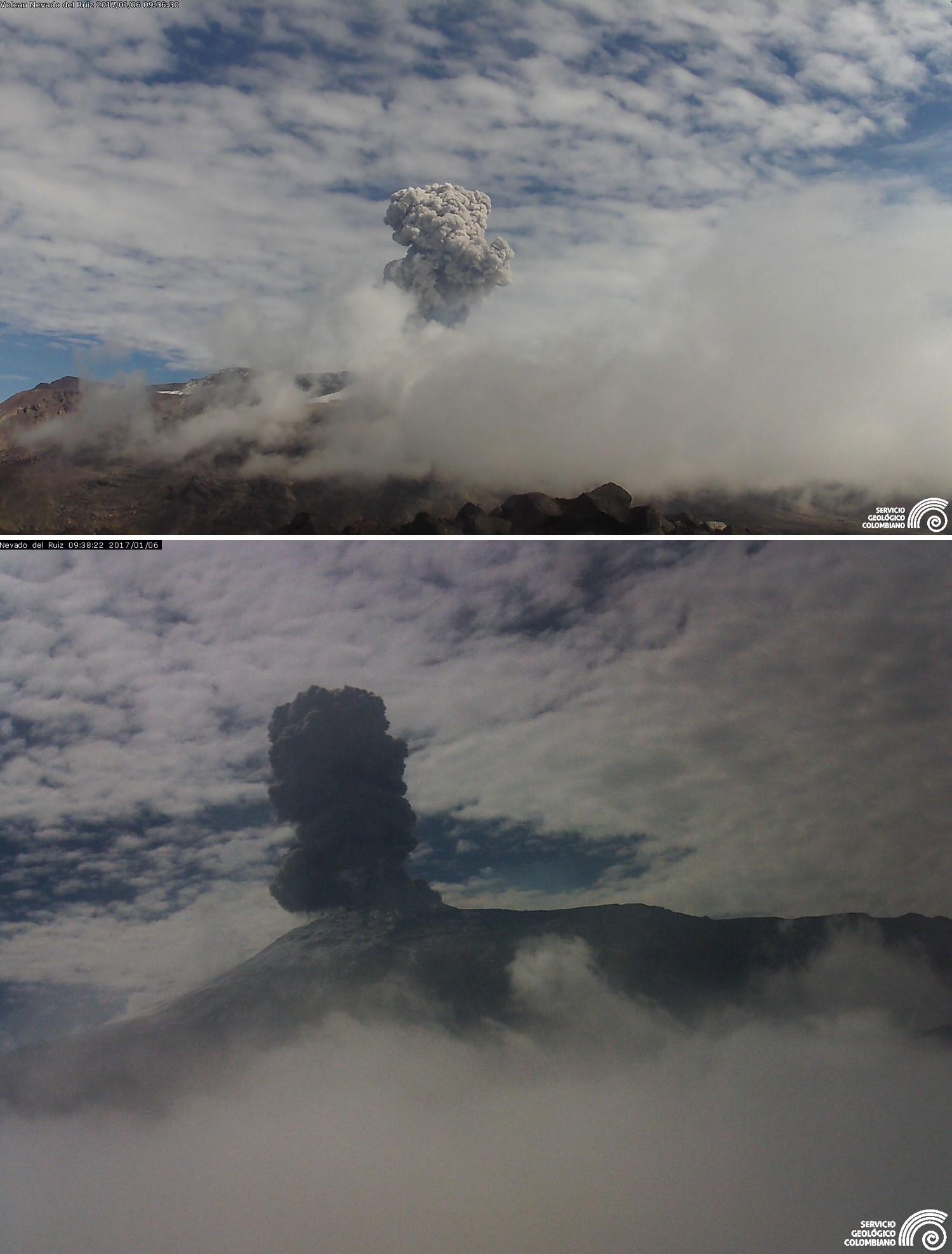 |
Figure 94. Ash plumes at Nevado del Ruiz on 6 January 2017. Courtesy of Servicio Geologico Colombiano. |
Thermal anomalies continued to be detected through March. Ash plumes continued to be observed and recorded in seismicity and maximum heights of 2 km above the volcano were noted. Deflation continued after the intermittent inflation the previous month. On 10-11 April a period of short-duration and very low-energy drumbeat seismicity was recorded. Significant gas and steam emission continued through April with intermittent ash plumes reaching 1.5 km above the volcano. Thermal anomalies were detected early in the month.
Unrest continued through May with elevated seismicity, significant steam-and-gas emissions, and ash plumes reaching 1.7 km above the crater. Five episodes of drumbeat seismicity were recorded on 29 May and intermittent deformation continued. There were no available reports for June and July.
Variable seismicity was recorded during August and deflation was measured in the first week. Gas-and-steam plumes were observed rising to 850 m above the crater on the 3rd, and 450 m later in the month. A thermal anomaly was noted on the 14th. There were no available reports for September through December.
On 18 December 2017 the Washington VAAC issued an advisory for an ash plume to 6 km that was moving west and dispersing. The plume was described as a "thin veil of volcanic ash and gasses" that was seen in visible satellite imagery, NOAA/CIMSS, and supported by webcam imagery.
Geological Summary. Nevado del Ruiz is a broad, glacier-covered volcano in central Colombia that covers more than 200 km2. Three major edifices, composed of andesitic and dacitic lavas and andesitic pyroclastics, have been constructed since the beginning of the Pleistocene. The modern cone consists of a broad cluster of lava domes built within the caldera of an older edifice. The 1-km-wide, 240-m-deep Arenas crater occupies the summit. The prominent La Olleta pyroclastic cone located on the SW flank may also have been active in historical time. Steep headwalls of massive landslides cut the flanks. Melting of its summit icecap during historical eruptions, which date back to the 16th century, has resulted in devastating lahars, including one in 1985 that was South America's deadliest eruption.
Information Contacts: Servicio Geologico Colombiano (SGC), Diagonal 53 No. 34-53 - Bogotá D.C., Colombia (URL: https://www2.sgc.gov.co/volcanes/index.html); Observatorio Vulcanológico y Sismológico de Manizales (URL: https://www.facebook.com/ovsmanizales); Washington Volcanic Ash Advisory Center (VAAC), Satellite Analysis Branch (SAB), NOAA/NESDIS OSPO, NOAA Science Center Room 401, 5200 Auth Rd, Camp Springs, MD 20746, USA (URL: www.ospo.noaa.gov/Products/atmosphere/vaac); Global Sulfur Dioxide Monitoring Page, Atmospheric Chemistry and Dynamics Laboratory, NASA Goddard Space Flight Center (NASA/GSFC), 8800 Greenbelt Road, Goddard, Maryland, USA (URL: https://so2.gsfc.nasa.gov/); Sentinel Hub Playground (URL: https://www.sentinel-hub.com/explore/sentinel-playground).



